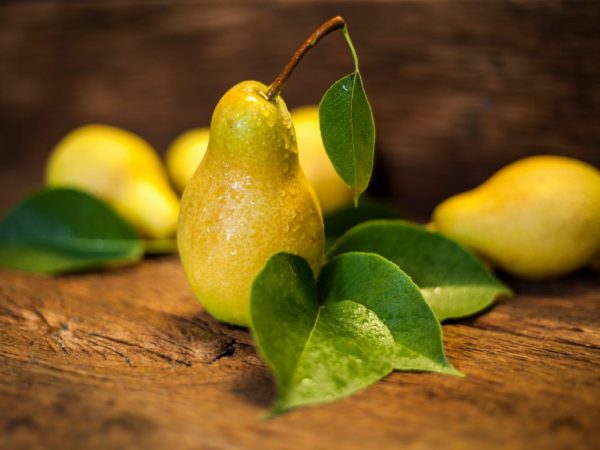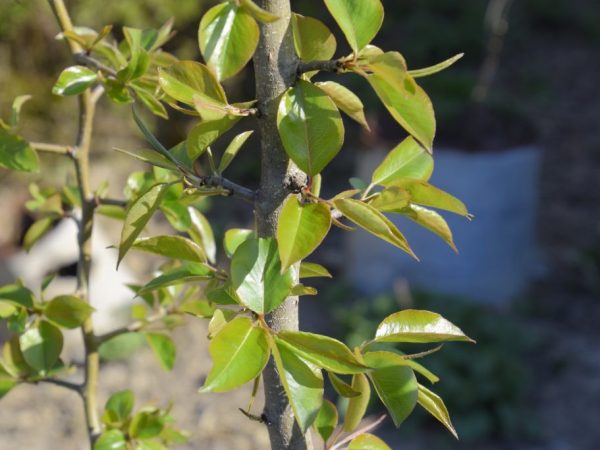Description of pear Forest beauty
The Forest Beauty pear was brought from Belgium. The variety has been renamed many times, so you can find such names as Forest Pear, Alexandrina, Flemish Beauty. Today he is known in all countries of Europe and even Asia.

Description of pear Forest beauty
Variety characteristic
The characteristic suggests that the Forest pear is self-fertile. But to increase yields, it is recommended to use pollinating trees, which include the varieties Bessemyanka and Limonka. The first fruits from a young plant are harvested already in the third or fourth year of life.
The variety is early ripening (summer), the fruits ripen in the second decade of August. Productivity depends on weather conditions: in hot summers there are much less fruits than in cool ones. In addition, they overripe and crumble rather quickly, so they are recommended to be harvested a week before they are fully ripe and processed as soon as possible. The shelf life depends on the conditions: if all norms are observed, the fruits are stored for up to two months.
Pear Forest Beauty is a dessert variety that is often used for preparing fruit salads, baking, drying, for preparations for the winter, and also consumed fresh.
Lesnaya pear belongs to frost-resistant, which makes it possible to grow it even in cold regions (the Urals and Siberia). It is unpretentious to the composition of the soil (except for clay) and to frequent watering. Plants are centenarians, they can even live up to 100-150 years.
Description of the tree
Trees grow very quickly. At the age of 10-12 years, they stop growing, reaching a height of 5-6 m (medium-high). The plants are sturdy, with a wide pyramid-shaped crown and thick branches. The leaves are deep green in color.
Flowering begins in April. Small-sized flowers have a pale pink hue, they can withstand sudden changes in temperature and cold well. In mid-May, the ovary is usually already formed.
Description of fruits
Fruits are medium in size and neat oval (more ovoid) in shape. Their weight ranges from 120 to 150 grams, but under suitable conditions, they can reach 250 grams.
The skin is thin, but very dense, due to which the pears tolerate transportation well. It has a yellow color with a golden tint, rusty specks are often present. With frequent exposure to the sun on the fruit, a pinkish blush is formed on them.
The forest pear is valuable for its taste. The pulp has a yellowish tint, very soft, juicy and sweet. Has a rich, but delicate taste and a pronounced aroma.
Landing
A very important step is the selection of a suitable seedling: the roots should not show any damage, the branches should be sufficiently flexible or intact.
Planting seedlings should be carried out in late April - early May, but not earlier than a week after the snow melts. The place where the tree will grow should be well lit and protected from strong drafts.
As for the soil, the only exception is clay: the seedling will not grow on it. But the soil must be loose. Before planting, it is necessary to remove all weeds from the site.

The development of the tree depends on the correct planting.
The pit is also prepared in advance: usually, a week before planting. It should be deep (about a meter) and 60-70 cm in diameter. The soil is mixed with humus and sand (20 kg each), and potassium sulfate (100 g) and 200 g of superphosphate are also added. This mixture is poured onto the bottom of the pit, three buckets of water are poured, after which the plant is carefully lowered there and covered with soil.
It is important to ensure that the neck remains above the soil surface. After planting, the soil around is tamped well and the seedling is tied to a peg. The variety is perfect for a stock next to summer or early autumn tree species.
Care
The description suggests that this variety is picky to care for. A good harvest can be harvested if the basic recommendations are followed.
Watering
To carry out correct watering, a small circular ditch is dug at a distance of 40 cm from the trunk, into which water is poured. Forest pear is demanding for watering only in the first years. Young trees should be watered every week with two buckets of water. In addition, it is important to monitor the plants during the fruiting period: they must be watered before flowering and twice during fruit ripening. The rest of the time, the trees are watered when the soil around them begins to dry out.
Pruning
The first pruning can be done in the second year of the tree's life in order to properly form the crown. After the tree begins to bear fruit, pruning is done annually. This significantly increases yields and helps to remove excess and dry branches.
Top dressing
The forest beauty should start feeding pears from the second year of life. It is necessary to use both organic and mineral fertilizers. The frequency of their introduction depends, first of all, on the soil on which the tree grows.
In spring, humus with water is introduced into the soil in proportions of 1: 1. In summer, it is good to use phosphate-potassium fertilizers and a solution of wood ash. At the end of fruiting, add superphosphate with potassium chloride, urea or wood ash.
Other procedures
The description of the variety suggests that it is necessary to regularly loosen the soil on the site and remove weeds. Also, with the onset of cold weather, very young trees should be sheltered, including from rodents.
Possible diseases
The Forest Pear is immune to many diseases and is rarely attacked by insects. The main and only enemy of the Forest Beauty is scab. It infects plants after frequent rains, even abundant morning dew and fallen leaves may be the culprit.
To avoid infection, it is necessary to remove all fallen leaves from the site and regularly remove weeds, spray with Bordeaux liquid and regularly prune the crown.
Advantages and disadvantages
Benefits:
- good productivity;
- excellent taste of fruits and the versatility of their use;
- their high transportability;
- resistance to many diseases;
- undemanding to care and resistance to frost.
Disadvantages:
- instability to scab;
- fast overripening and falling of fruits.
Conclusion
The characteristics show that along with the advantages, the variety also has disadvantages. The reason is that it belongs to a fairly old species. But, nevertheless, its significant advantage is the exceptional taste of the fruit, as well as frost resistance, which makes it possible to grow plants in regions with a cold climate.

